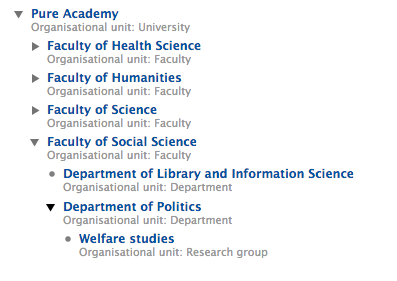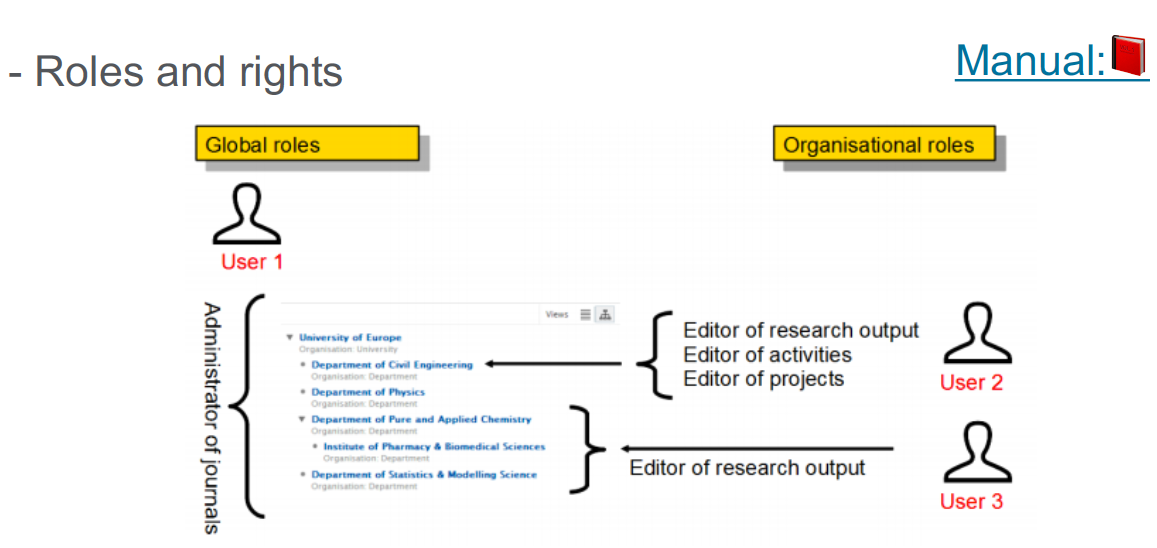How Can We Help?
Pure Academy: Basic classPure Academy: Basic class
Basic concepts
This section describes the fundamental content types used in Pure. They are important as they are a foundation upon which most other content types are built, and they are key for relating content, so that one Organizational unit has a number of Persons (Employees) related. And these Persons have different content types as Research output, Activities, Projects etc. related to them and thereby also to the Organizational units.
Organisational units
![]()
Organizational units are a research institution's schools, faculties, institutes, departments, and so on; any type of organization that can be thought of. These units are often organized hierarchically, and when they are, that can be modeled correctly in Pure. Pure can also hold temporary or "virtual" research organizations, also referred to as research groups or cross-departmental units. They can be separate from the formal hierarchy but it is still possible to use them in the same way as the formal organizational units. Pure offers full freedom to model organizational units and research groups in the system in exactly the same way they are set up in real life; you can, for example, also have multiple hierarchies in parallel, and you can let organizational units have multiple parents.

There are many different types of organizational units; in a traditional hierarchy, you will have the university at the top, then faculties or schools, departments or institutes etc. In addition, Pure can work with non- hierarchical research groups, sometimes also referred to as virtual or temporary organizations. System administrators or other local staff define the different types of organizations during the implementation of Pure, or at a later stage. There is no limit to the number of organizational unit types that can exist in Pure.
Pure also keeps track of an organizational unit's status (active or inactive); an organizational unit's status is very important for how it functions in the realm of other data in Pure - see more in the "Organizational units management" section below. Organizational units are related to a large number of other types of content, most fundamentally to the Persons (Content type) and their productions (Research outputs, Activities, Prizes, Projects etc.)
Organizational unit key metadata
| Metadata | Description |
|---|---|
| Type | For categorization of the organizational units |
| Name | Useful for re-finding... |
| Life cycle of the organizational unit | Keeps track of the start and end date of an organizational unit as well as information on which that has taken over a unit. |
| Place in hierarchy | Used for setting the nearest parent organizational unit in the hierarchy. Multiple parents can be set for sharing a unit. |
| Addresses | Both physical and virtual addresses can be added. Geolocation can be used to pinpoint on a map. |
Where does Organizational unit metadata come from
HR systems, finance systems, payroll systems, and authentication services like Active Directories or LDAPs often already contain parts of this information. Therefore, automatic systems integration is usually set up between such external data sources and Pure to facilitate the process of creating and updating organizational units in Pure when they are created and updated in the sources (the above-mentioned external systems). This is done either via a continuous synchronization or via import from a structured file.
Organizational unit management
At a university, organizational units can be closed, opened, merged, split, or they can take over each other. These events are modeled correctly in Pure and they are handled without loss of history, which is allows for correct and reliable reporting both in retrospect and in present time.
In most cases, such events are reflected automatically in Pure as they happen in the HR system: Closing a department in the HR system will simply cause the same organizational unit to become "former" in Pure. More complex events may not be supported in HR systems, and because of that Pure offers administrators a set of features for manual handling of organizational unit structures when necessary.
A good example is a Pure feature called "Taken over by". It allows an administrator to let one organizational unit take over another. When doing that, all content (e.g. publications) formerly associated with the overtaken organizational unit will be associated with the overtaking organizational unit without loss of the information that the overtaken organizational unit once existed and that certain content was produced there.
Pure's feature set for management of organizational units includes special features, three of which are mentioned below.
Roles related to Organizational units
| Role | Key actions | |
|---|---|---|
|
Editor of organizations |
|
Subset is defined in the role assigning. |
| Administrator of organizations |
|
This is often managed via synchronizations |
| Administrator of organization-based import scan |
|
The actual import of results is done by other roles |
Person

A Person in Pure represents an internal employee (internal person): someone currently working at your institution, typically as a researcher or an academic. This is represented as a set of metadata on what is registered about the researcher, for example name, affiliation, key subject areas of research, and more.
Person key metadata
| Metadata | Description |
|---|---|
| Name, name variants | Name and name variants for example Known as, Default publishing name or Former name |
| Scopus Author ID | A unique identifier from Scopus. Extremely useful for matching content. |
| ORCID | A widely accepted unique identifier for researchers/authors. Adding an ORCID to the profile will allow synchronization of list of research outputs to ORCID profile/listing. |
| Curriculum and research description | Use to fill in free text description of various areas of interest divided into a number of headings. Can be re-used in a CV. |
| Organizational affiliations | Keep track of current and previous employments at the institution. |
Where does Person metadata come from
HR systems, finance systems, payroll systems, and authentication services like Active Directories or LDAPs often already contain parts of this information. Therefore, automatic systems integration is usually set up between such external data sources and Pure, so that information about Persons is created and updated automatically in Pure when it is created and updated in the sources. This can be achieved either via a continuous synchronization or via import from a structured file.
Roles related to Persons content type
| Role | Key actions | Notes |
|---|---|---|
| Editor of Persons |
|
Subset is defined in role assignment |
| Administrator of Persons |
|
Often managed via synchronizations |

User

A user is assigned to all who need access to Pure. Users can only operate in Pure if they either are assigned a role (dedicated working tasks) or are combined with a Person, which makes them Personal users.
Personal user
 +
+ 
Pure term used to identify a researcher. This is simply the combination of a Person and a User, which essentially means that researchers (Person profile) are able to login (User account) to Pure and see/modify their Person profile.
Published at December 04, 2023
